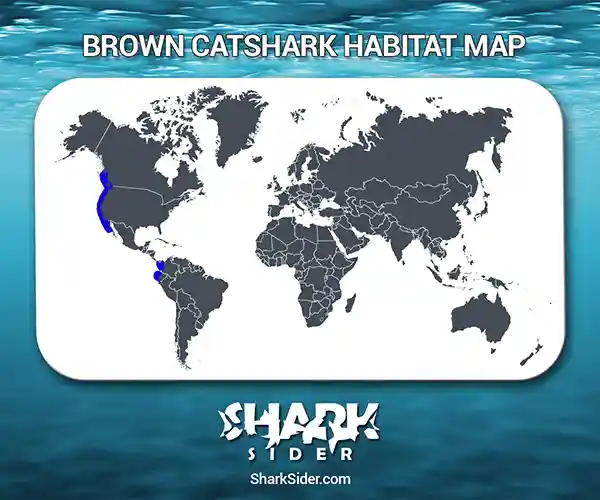The brown catshark is a bottom-dwelling shark found in the eastern Pacific Ocean. These small sharks have soft and flabby bodies and belong to the family Scyliorhinidae.
Brown Catshark Scientific Classification |
|
| Kingdom | Animalia |
| Phylum | Chordata |
| Class | Chondrichthyes |
| Order | Carcharhiniformes |
| Family | Scyliorhinidae |
| Genus | Apristurus |
| Scientific Name | Apristurus brunneus |
Description
The average body lengths of both mature males and females are 1.5-1.6 feet and 1.4-1.6 feet, respectively. The biggest ever shark recorded measured 2.3 feet.
Their upper side has a dark brown coloration, and their fins have a faint posterior margin.
These sharks have elongated bodies with a broad head consisting of big nostrils and a snout shaped like a bell. They have a long, arched mouth consisting of elongated labial furrows and extend to the other side of their eye level.
The jaw consists of rows of teeth, with the teeth in the lower jaw shorter than the upper teeth.
The skin of these sharks is soft and weak. It is, therefore, an unsuitable body feature, as any external damage can easily harm the shark.
The dorsal fins of these catsharks are equal in size and lack spines. While the first dorsal fin originates at the front of the dorsal fin, the second dorsal fin is located in front of the insertion of the anal fin. They have a long caudal fin.
Where do they live
Map Of The Brown Catshark’s Habitat

These sharks are spread all across the Pacific Ocean. Its populations are distributed across British Columbia, southwards to the Baja California peninsula in Mexico, Panama, Ecuador, Chile, and Peru. They are also found at the Icy Point in southeast Alaska, to the Gulf of California.
They live in cold depths of 108-4259 feet and inhabit muddy and sandy waters of outer continental shelves and upper slopes. These sharks are generally bottom dwelling but are sometimes caught swimming in mid-water.
Dietary
The general diet of the brown catsharks consists of many bottom-dwelling species, such as small shrimps and other small crustaceans, squids, and small fish.
Reproductory
The brown catshark follows an oviparous mode of sexual reproduction where the females lay pairs of eggs (single egg per oviduct) inside egg cases. These egg cases are transparent with tendrils attached to them (which helps the egg cases anchor to hard surfaces) and measure 2 inches long and 1 inch wide.
The incubation period lasts for about a year. In some places like Canada, females carry the eggs from the months of spring (February to August).
Eggs take almost a year to hatch with each hatchling measuring 2.75-3.54 inches.
Adaptations
These sharks have an ability that helps them to detect weak electrostatic and magnetic fields emitted by other animals in their environment. This adaptation helps the shark navigate effectively. They also have a well-developed sense of smell.
Interactions with humans
Overfishing, and being a common bycatch of deep-water fishing trawlers, has reduced the population of these sharks as the process damages their soft bodies. Brown catsharks are listed as ‘Data Deficient’ on the IUCN Red List because of insufficient information on their reducing population.
There are no conservational practices currently underway to protect their numbers.
